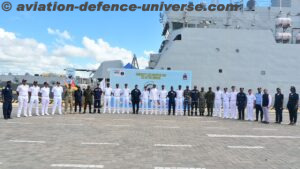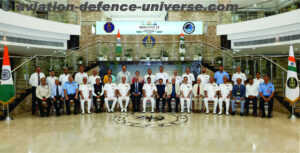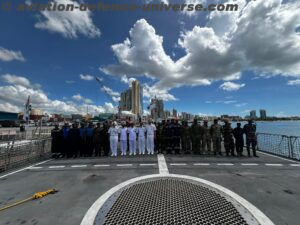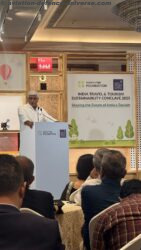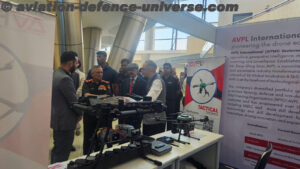- Stealth & strength of Indian submarine force is smooth sailing in turbulent waters
By Commodore Anil Jai Singh
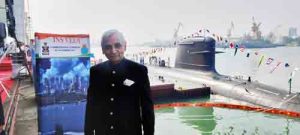
Mumbai. 27 November 2021. On 25 November 2021, INS Vela, the fourth of the six Kalvari class submarines being manufactured at Mazagon Docks Ltd was commissioned into the Indian Navy. Based on the French Scorpene class design and built in collaboration with Naval Group of France, these submarine displace about 1750 tonnes and are armed with a mix of heavyweight torpedoes and torpedo-tube launched anti-ship missiles. Their design incorporates contemporary stealth features thus minimising their acoustic, thermal and magnetic signatures and making their detection a challenging task for the adversary. These submarines are fitted with a fair amount of indigenous equipment which is repeatedly emphasised in the current era of ‘Make in India’ and ‘Aatmnirbhar Bharat’.
A submarine is an extremely complex system of systems and is the reason why only a handful of nations in the world can build them. Countries in the west comprising the USA, UK, France, Sweden, Germany, Spain and Italy have been building submarines for over a century ; they have pioneered numerous submarine technologies and are at the cutting edge of submarine design and development. Japan, Russia and China are perhaps the only countries in the rest of the world that can lay claim to keeping pace with the west in varying degrees. Japan has recently commissioned the world’s first submarine powered by lithium-ion batteries instead of the traditional lead –acid type used all over the world. Other countries are at various stages of developing these.
The other submarine building countries – South Korea, India, Australia,Turkey, Greece, Brazil, Pakistan etc are building submarines in collaboration with foreign OEMs or based on the OEM’s designs. South Korea’s latest class, the KSS-III is a much larger and better armed indigenously designed submarine though the basic design cues of the German Type 214 are unmistakable. India too is attempting a transformational shift in submarine construction with the Project 75(I) programme which is the first programme being progressed under the Strategic Partnership model introduced by the Ministry of Defence in 2016. Project 75(I), like the Project 75, also envisages the construction of six conventional submarines at an Indian shipyard, designated a Strategic Partner, in collaboration with a foreign submarine manufacturer with the intention of obtaining the expertise for indigenous design and development and deep transfer of technology so that future submarine construction programmes are ‘Made in India’ in all respects.
India presently has 16 conventional submarines with INS Vela being the latest. Of these, seven Sindhughosh class submarines of Russian origin and two Shishumar class submarines of German origin are more than 30 years old whereas INS Sindhushastra, the IN’s first missile firing submarine and the other two Shishumar class which were built in India are between 22 and 29 years old. These submarines have been kept in fine operational fettle with regular sensor, weapon and machinery upgrades and remain the backbone of India’s undersea warfare capability. Time and tide however wait for no one and by the end of this decade they will be another nine years older and limited in their ability to shape the technology driven futuristic maritime battlespace. It is therefore the six Kalvari class submarines, the last of which should hopefully get commissioned by 2024 that will provide the Navy its cutting edge offensive capability well into the next decade since the operational availability of the Project 75(I) submarines before 2034 or so seems very unlikely at present.
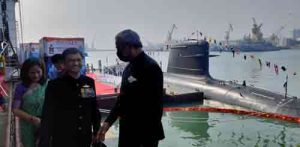
Submarines by the very nature of their operational role are required to go in harm’s way and take the fight to the enemy. They must therefore be equipped adequately to do so. The contract for the P75 programme was signed in 2005 when many of today’s common place technologies were not so common and therefore these submarines, despite their contemporary design features and current technology lack some fundamental capabilities that are par for the course in contemporary submarines. Perhaps the most glaring of these is the lack of an Air Independent Propulsion System. Most modern submarines are fitted with AIP systems which greatly enhance a submarine’s dived endurance, or more simply stated, its ability to remain dived without needing to expose its masts on surface to charge its batteries. Optimally, an AIP submarine can remain dived without charging batteries for three to four times the duration of a non AIP submarine which has to recharge batteries at least once in two to three days if not more often depending on its mission and operational profile. In the Indo-Pacific itself, AIP submarines are being operated by China, Japan, South Korea, Singapore and Pakistan. While China, Japan and Singapore operate the Swedish Stirling system, South Korea operates the German fuel cell system which it has now indigenised and claims it as its own and Pakistan operates the French MESMA System. The Indian DRDO has also been developing an indigenous fuel cell AIP system, the land based prototype of which has been tested. DRDO is confident that its AIP system will be ready for installation on the first Kalvari class submarine during its first mid length refit which could be in about three years from now. The remaining five submarines will also be subsequently retrofitted with these AIP systems. For the sake of India’s maritime security, it is hoped that DRDO’s optimism is not misplaced.
India’s maritime imperatives demand the ability to dominate the underwater domain in the Indian Ocean through multiple capabilities in the air, on the surface and below the surface. While air and surface underwater capability is primarily aimed at neutralising the adversary’s submarine threat, the sub surface capability is also aimed at neutralising or substantially degrading the adversary’s surface war fighting effort through a potent mix of heavyweight torpedoes and anti-ship missiles which are now being superseded by land attack capable missiles that provide a submarine the capability to also influence the outcome of the war on land. Imagine the effect on the enemy of a critical strategic facility located hundreds of miles inland getting destroyed by a missile attack launched from seawards by a platform whose location is unknown.
China’s naval expansion programme, its expanding footprint in the Indian Ocean and its arming of the Pakistan Navy with considerable surface and submarine capability to be used as a proxy by China in support of its strategic objectives is no secret and will present a formidable challenge to India’s pre-eminent position in the Indian Ocean and a threat to India’s trade and energy security. As a regional power and a provider of net security in the Indian Ocean, any vulnerability in India’s maritime posture in the region will shake the confidence of its maritime neighbours and erode its credibility to protect their interests thus creating a power vacuum that could be exploited by China to its advantage.
The Project 75(I) programme currently being progressed by the Navy and the MoD has failed to generate the momentum required to address the imminent reduction in India’s subsurface capability by the end of this decade. The numbers will probably remain about the same but in nine years from now, all except six submarines will be 30-45 years old. The only way to accelerate this programme is to delink it from the onerous Strategic Partnership model which despite its noble intentions is bound to face delays as there are bound to be procedural issues at every stage in the process which will need to be sorted out, thus delaying the acquisition of new submarines even further. Instead of the 24 submarines envisaged in the 30 Year Plan by 2030, as it is the Indian Navy will get only six.
There are only a handful of global submarine manufacturers and the details of their products and capabilities are common knowledge. India has been operating submarines for 54 years so there is no dearth of experience in the navy and the submarine arm to assess which of the available designs and manufacturers are best suited to deliver the capability that the navy requires. In the interest of national security , the procedural merry- go-round should be dispensed with at the earliest. The Government of India should directly negotiate with the most suitable OEM and initiate a G2G arrangement with the country that the OEM belongs to while applying a more sophisticated method of price discovery than the dysfunctional L1 process and get the programme moving.
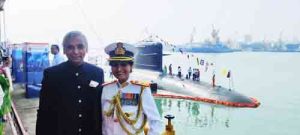
The Project75 (I) is expected to be followed by six more conventional submarines manufactured to an indigenous design and six nuclear propelled attack submarines (SSN). These ambitious programmes will be even more challenging than Project 75(I). Therefore, its smooth and speedy conclusion is absolutely essential. The time for prevarication is long past and procedural bottlenecks either need to be addressed or circumvented. The threat to India’s security and interests in the maritime domain is very much in the here and now and addressing it expeditiously is an inescapable imperative.






































